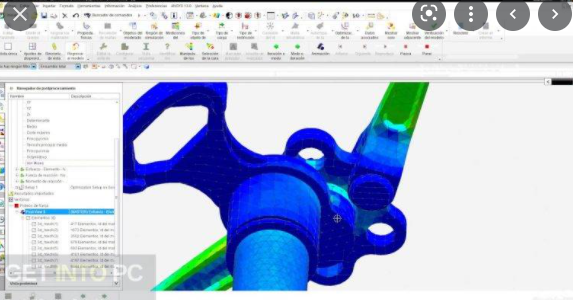NASTRAN’s success led to the development of other finite element software. ASTROS, which extends NASTRAN’s capabilities to include structural optimization, is one such software. NASTRAN was created to aid in the design of more efficient space vehicles, such as the Space Shuttle. NASA’s Office of Technology Utilization released NASTRAN to the public in 1971. NASTRAN’s commercial use has allowed for the analysis of elastic structures of all sizes, shapes, and purposes. The automotive industry uses NASTRAN to design front suspension systems, steering links, and other related functions. It can also be used to design railroad tracks, cars, bridges, and power plants, as well as aircraft and skyscrapers.
Siemens Nx Nastran 12
Password 123
Structural Analysis Toolkit is a general-purpose result manipulation toolkit that can be used to create solutions for Nastran within the Femap environment. It is possible to display results in ASCII text and Universal formats by processing data from the NASTRAN binary results files.
NX Nastran software is used by engineers as well as manufacturers of electronics, medical devices, and automotive industries. NX Nastran Aeroelasticity allows for efficient simulation of the interaction of aerodynamic and inertial forces. This is useful when structures are exposed to high, static, or time-dependent loads. This information can give critical performance information as well as insight into the aerodynamic behavior and suspension bridges of planes, helicopters, missiles, and other aircraft. There are many Mach performance numbers.
NASA approved NASTRAN as the official name for the program. It is an acronym that NASA STRucture ANalysis created. The MacNealSchwendler Corporation began to market and support NASTRAN in the 1960s. It was called MSC/NASTRAN. Joe Mule, Gerald Sandler, and Stephen Burns developed the original software architecture.

NASTRAN is used worldwide in the aerospace, automotive, and maritime industries. NASTRAN has been cited as the industry standard for the basic analysis of aerospace structures. There are four types of analysis available: static, dynamic, elastic, and linear. It can be used to solve a wide range of advanced problems such as NVH in various industries, including aerospace and automotive. 1964’s annual review of NASA’s structural dynamics program found that each research center was developing its own structural analysis software. Instead, a single program of generic software should be used.
This makes it possible to summation complex stresses, margins for safety, grid points and element forces, mod analysis summaries, random or harmonic base excitations, and other complex elements. The Toolkit saves valuable analysis time by making it easier to manipulate multiple data blocks and organizing results data. NASTRAN-CMG is built from the same base code that NASA’s original NASTRAN software. It includes the original NASTRAN architecture, DMAP language, and unlimited problem sizes.
Multiple Solutions
Many Nastran vendors also offer advanced nonlinear capabilities in their products. You can download 6 full-off line setups of Siemens NX Nastran inch 2 for free. It solves most structural analysis problems, including non-linear and linear analysis, acoustics and dynamics, optimization, rotor dynamics, and aeroelasticity. NX Nastran Super Elements are a way to reduce complexity and the resource requirements of large analysis problems. You can either process the simulation results individually or all at once using Super elements. MSC Nastran was the first commercial Nastran product, and it was created by Robert Schwendler and Dr. Richard MacNeal in 1963. It is used in all industries, but it has a strong following in the aerospace and automotive industries.
Nx Nastran Solution Sequences
Femap’s assembly management software makes it easy to set up a glued connection and linear surface-to-surface contact. These connections can be made between geometry surfaces or element faces. The aeroelastic analysis allows the analysis of structural models when there is an airstream. NX Nastran was the result of an FTC investigation against MSC Corporation regarding alleged antitrust activities. UGS purchased a perpetual, royalty-free perpetual license for MSC.Nastran 2001. Nastran’s CAE capabilities were incorporated into NX Unigraphics CAD and other components, to create the EDS/UGS PLM Solutions product management suite.
Heat transfer capabilities can solve design and thermal analysis problems, as well as transient and steady-state temperature analyses. NX Nastran DMAP is a powerful programming language that allows users the ability to customize NX Nastran’s capabilities through custom applications and the installation of their own modules. NX Nastran DMAP includes its own compilers and grammar rules, which are closely linked to the core capabilities of NX Nastran. This allows you to explore linear and nonlinear problems, transient effects, steady-state, or steady-state, as well all three types of heat transfer, with the associated characteristics. Engineers can use rotor dynamic analysis to determine the critical speeds of their systems and design designs that avoid these unstable speeds. NX Nastran offers dynamic solutions that cover all aspects of dynamic phenomena, including frequency, transient, shock response, random loading, and frequency.
MSC Nastran’s capabilities have been continuously expanded since 1963. It can be paired with MSC Marc or LS-Dyna for highly nonlinear coupled analytical solutions. The Femap with NX Nastran Optimization module allows you to improve on existing designs by manipulating element properties like plate thicknesses or beam sections. Design can be optimized to reduce weight, but still, maintain specific responses like displacements and stresses. A wide range of NX Nastran analysis types can be optimized, including linear statics, normal modes, and buckling analyses.
These software tools allow you to import and simplify CAD geometry and mesh with finite elements. You can also apply loads and restraints. These tools allow users to submit the analysis to NASTRAN and then import and display the results graphically.
This allows them to create safe, reliable, and optimized designs in shorter design cycles. It solves many structural analysis problems for final and nonlinear evaluations, acoustics, and dynamics.
Siemens Nx Nastran 12 System Requirements
- Memory (RAM): 4 GB of RAM required.
- Operating System: Windows XP/Vista/7/8/8.1/10
- Processor: Intel Dual Core processor or later.
- Hard Disk Space: 1 GB of free space required.
